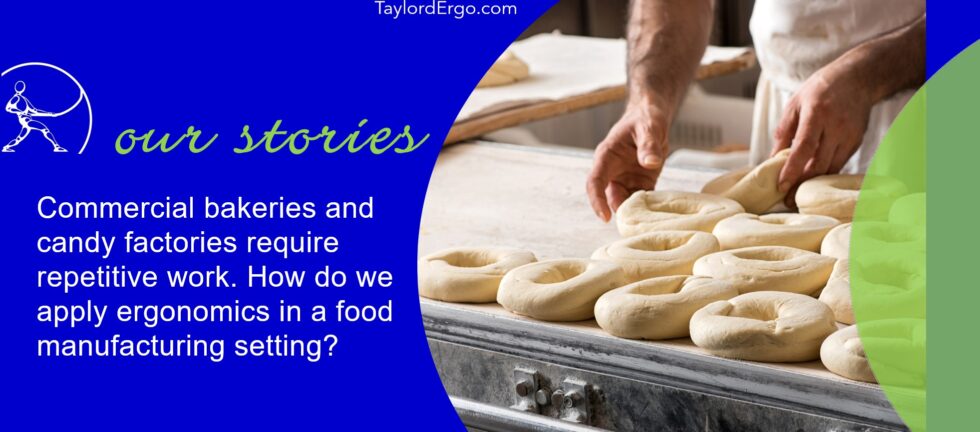We work with many clients in the food sector, including bakeries, confectioneries, poultry processors, dairy, mills, and even pet food. In this week’s article, we share a bit of what we’ve learned about ergonomics in food manufacturing.
How is this sector unique?
One of the unique things about food production is the amount of personal protective equipment (PPE) and “Good Manufacturing Practices” equipment that is required, including nitrile gloves, hair nets, beard nets and uniforms. These additional layers can increase gripping demands for some tasks. At first, it felt odd to gear up to collect data, but the routine quickly becomes normal.
In some food environments, more than one product can run on the same line. This means that one “job”, observed on Monday, might look very different on Tuesday. Understanding the variability between products can be tricky, especially if you’re not there to see it.
The nice part about working in a food environment, aside from the “perk” of shopping at the company store (mmm, chocolate, cookies, and more), is that some of the jobs are cyclic, so they can be faster to assess and improve than, say, a healthcare aide or an electrician. (Of course, most food clients ALSO employ maintenance workers and other operators who do perform complex and variable work.)
What approaches have worked best for you?
Callum says, “I try to understand the entire process first, and work down into more specific understanding from there. Having at least a general idea of the steps before and after the task you are assessing helps to make sure that you don’t miss anything important.”
What are the biggest ergo challenges in this sector?
Some measurements are particularly challenging to take while maintaining food safety protocols, and additional cleaning is acquired to make sure that our measuring equipment is safe to use in the production areas.
Our recommended solutions also have to be “food-safe” which often means that they are more expensive. Ideas generated in an industrial environment will often still apply in a food setting, but we need to find vendors who are able to meet the specific sanitation needs of food manufacturing.
What advice would you give to someone who is responsible for MSD prevention in this sector?
Adjustability, and many other “ergo” changes such as lift tables, diverters, and tilters, can be difficult to integrate into food processing lines after they are installed. Therefore, building ergonomics into processes during the design phase is critical. Many of our clients require their vendors to have an ergonomics design review completed before their plans are implemented. This is the most proactive approach! Having plenty of experience with active food plants, we’re able to “see” the hazards in a design and provide cost-effective solutions for new designs.
In many food plants, multiple lines produce similar products. This gives us the opportunity to create and test a solution on one line, and, if it works well, roll it out on the other lines later. In this way, the assessment and intervention process can affect more people!
Working with food manufacturers gives us insight into where our food comes from. We’ve always been impressed with how sanitary these work environments are – we’ve never seen work practices that dissuade us from consuming our clients’ products. When one of our ergonomists visits a food client during the days before an in-person team meeting, we all show up keen to see what they’ll share!
FAQs:
What specific ergonomic interventions have been most effective in food manufacturing settings, and can you provide examples of successful implementations?
One effective ergonomic intervention that has shown success in food manufacturing settings is the use of adjustable workstations. These allow workers to modify their work heights and angles, reducing strain and fatigue. For instance, introducing lift tables at packaging stations has helped many facilities significantly decrease the risk of musculoskeletal disorders. Another successful implementation involved redesigning tasks to include mechanical assist devices, which not only improved safety but also enhanced overall efficiency.
How do you measure the impact of ergonomic improvements on worker safety and productivity in food processing environments?
To measure the impact of ergonomic improvements, facilities often conduct pre- and post-implementation assessments that track key metrics such as injury rates, worker feedback, and productivity levels. By collecting data on incidents of musculoskeletal disorders before and after ergonomic changes, organizations can quantify the effectiveness of their interventions. We use a baseline and follow up employee survey to gather workers’ perceived productivity, quality, comfort, and engagement.


